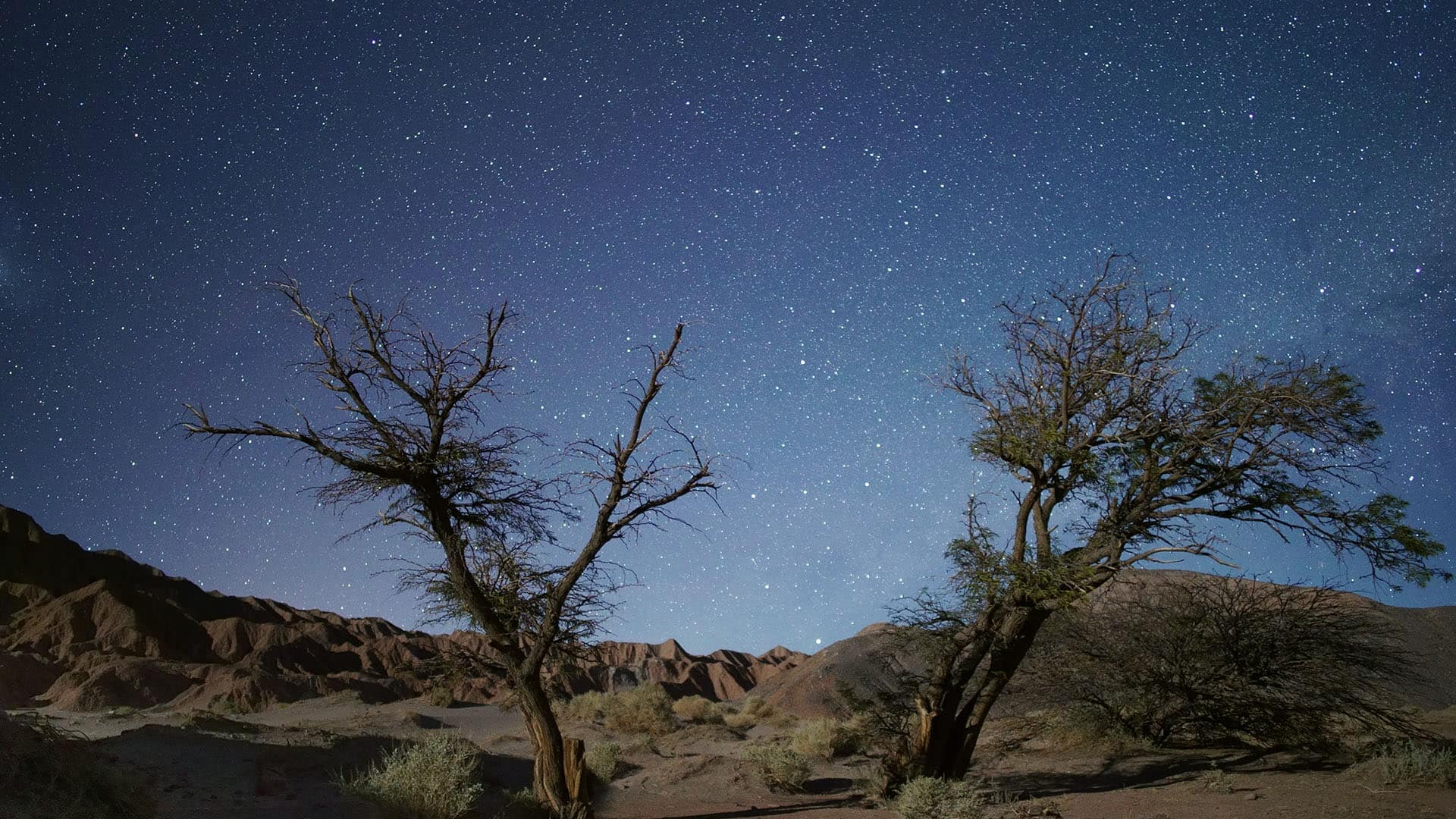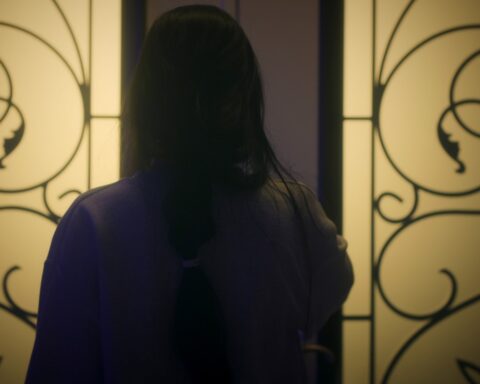I’m generally opposed to the idea of working vacations, but transcribing an interview with Cielo director Alison McAlpine while at my cottage gave her words extra gravity. There is something about the stars that too many of us take for granted. Back home in Toronto, the only blinking lights in the sky are airplanes. I used to be able to see the moon, but then the condominiums all had growth spurts. At my cottage in Quebec, an hour away from the light pollution of Ottawa, looking upwards at night feels like taking a trip to another planet. There are just so many wonderful stars in the sky.
McAlpine’s Cielo is an awesomely beautiful and poetic contemplation of the stars. Urban audiences in particular will be struck by the profound expansiveness of the skies that McAlpine captures from Chile’s Atacama Desert. Cielo looks to the stars with endless curiosity and wonder as McAlpine stargazes with the local residents and scientists at Las Campanas Observatory and La Silla Observatory. The film considers the power of the universe beyond Earth’s surface through lenses of faith, science, poetry, and existentialism. One is humbled by the grandeur of the sky as Cielo observes poetry in motion simply by tilting a camera upwards to watch nature pass us by. The sad reality of seeing the sky in Toronto versus watching the stars at TIFF Bell Lightbox is that nature looks so much better on the big screen for city dwellers.
POV chatted with McAlpine by phone ahead of Cielo’s theatrical release to discuss the stars and the ideas of the great beyond they inspire.
POV: Pat Mullen for POV
AM: Alison McAlpine
This interview has been edited for brevity and clarity.
POV: I wanted to start by asking a question that you posed the subjects in the film. What is your connection to the stars?
AM: I grew up in Vancouver. When we went camping in the north of the province, I always loved watching stars. The real catalyst for the film came when I was in Chile. I was in a tiny village and out walking one night when there was no moon — all of a sudden the lights went out. I looked at the sky and it was like I was seeing it for the first time. I had never seen such extraordinary beauty in my life. So extraordinarily intense.
POV: Can we talk a little bit about the characters in the film? You seem to have an affinity for Roberto. What drew you to him?
AM: Characters are hugely fundamental to me in all my work. Roberto is an extraordinarily natural storyteller. Hr comes from an oral tradition and he knows how to tell a grand tale. Like all the characters, he has a connection to the sky, but more than that, he has a humour and humanity that expresses a poetic sensibility.
POV: I read that you have a background in poetry and that Alistair MacLeod described your work as “film poetry” for the visual elements. Can you tell me a bit about the poem that might’ve inspired him to make that comment?
AM: It was more a body of work than one poem. When I was writing and publishing more poetry, they were really more like poetic monologues. That was what drew me to theatre. There were all these characters and I could make them more rhythmic. My work’s always been visual in poetry and in theatre. Actors were encouraging me to go into film because I was imagining things in cinematic terms and they felt it had to be translated into theatrical ones.
POV: Watching the film, I assumed that some of the more far out imagery was shot through the observatory, but while reading more about it, I learned they’re what you call “organic effects.” Can you explain the process of creating these images?
AM: No, we never did that. [Shoot through the main telescope of the observatory.] We had some shoots with telescopic lenses fixed to the camera with adapters. Those can be extraordinary images and we got some interesting footage. NASA also has great images, but we’ve seen that. I was inspired by Terrence Malick’s The Tree of Life, particularly the creation of the world sequence. We used that in the rough cut. I watched a little video about how one does organic effects, and of course, it’s very complicated. It requires a fancy camera that can shoot at 2000 or 4000 frames per second.
I wanted something that could provoke our imaginations and create intimacy with the stars and a texture we hadn’t seen before. We played with the imaginations of the scientists featured in the film and put these images on screen, like Néstor’s story about the journey of light from a star to the telescope. I gathered a crew and we shot for three days in Montreal. It was like a professional film shoot where we had to plan it with storyboards and lights. Then we improvised with organic materials to create lights and planets. We layered both in post to create textures that would evoke our imaginations.
POV: There’s also a very nice lesson in the film about light pollution and the human activity that can prevent that. What can audiences do to help make the stars visible again in the city?
AM: We’re in contact with various dark sky organizations to convey the point. It’s possible to use lights that are friendlier and would allow us to see the sky. That requires fundamental changes, costs money. I went back to do that time lapse you see at the end of the film which is at a place where we filmed with the Swiss team. Part of the reason for the angle of the shot is because the light pollution was much worse than when I was there six or eight months before. Many astronomers won’t use that observatory anymore because the light pollution is getting to be too much. The Chilean government put in a highway near the observatory and they’re putting in a massive amount of new lights for safety, but they’re not the lights that were suggested by people who are fighting to reduce light pollution.
It would be a big change, but I think we should petition to embrace the sky as part of the natural environment. Most of us live in cities and we don’t see the sky because we feel we live on a horizontal plane. If we don’t see it, we don’t feel we are inside our universe, inside our sky. If you don’t experience that, it’s hard to fight for it.
POV: Cielo has a nice dialogue between science and faith. The film introduces the sky through a scientific lens with the observatory and then we see it through different viewpoints, like faith or philosophy. Did you have more questions than answers by the film’s end?
AM: I don’t see a conflict between a scientific gaze and one that is mythic or spiritual. What’s fascinating is what we project upon the sky—science, myth, the dead. What don’t we project on the sky? What’s behind those projections? I think science does its share of projecting in a similar way to how our gods project onto the sky—whichever god one believes in. The scientists in the film are very much philosophical poets too.
What comes to mind is Mercedes, the scientist we meet in the beginning at Las Campanas Observatory. When we first met, she said to me that if everyone could see the night sky as beautifully as she sees it in Chile, maybe it would make us all a little more human, a little more humble. What comes with that, for her as a scientist, is embracing all the complications and reflections entailed in that feeling.
Cielo opens Friday, Aug. 10 in Toronto at TIFF Lightbox and in Montreal at Cinema Beaubien and Cinema du Parc. It opens in Ottawa at The ByTowne on Wednesday, Aug. 15.
Cielo – Official Trailer from Alison McAlpine on Vimeo.












